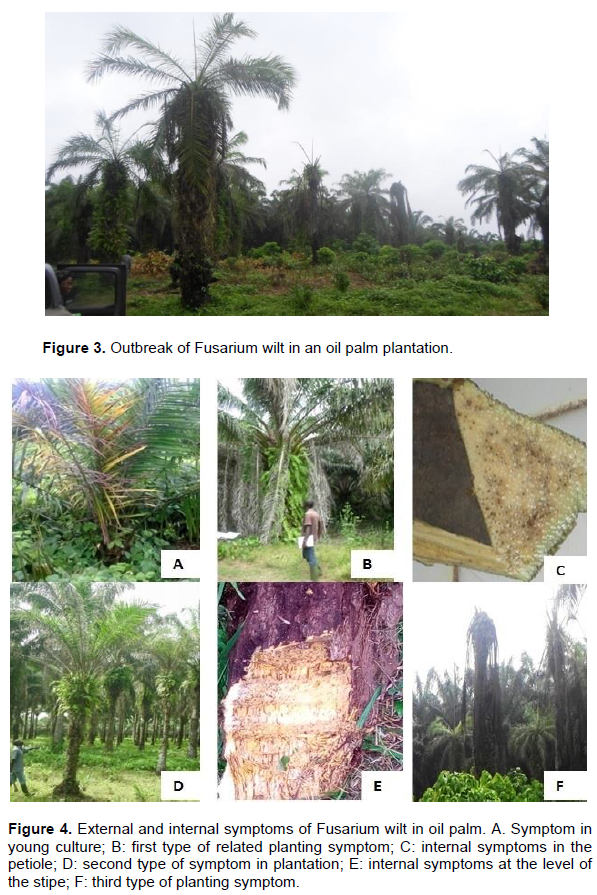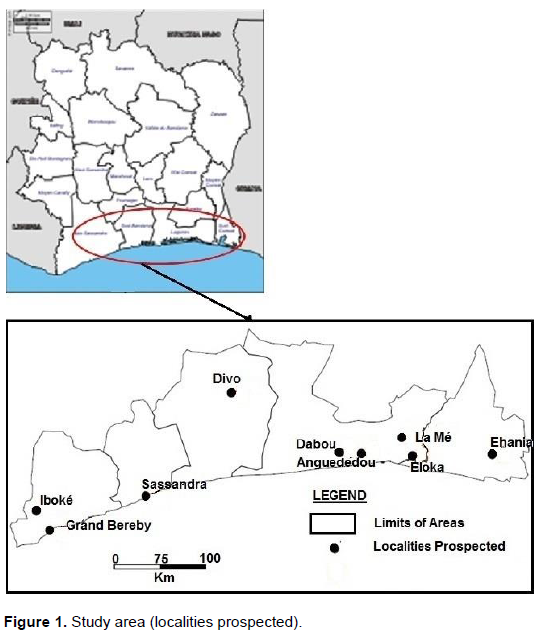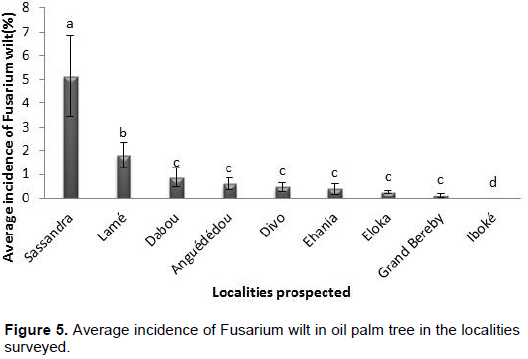ABSTRACT
Fusarium wilt of oil palm is caused by Fusarium oxysporum f. sp. elaeidis (Foe) and is particularly prevalent in Africa. This work shows prospect in the industrial and village oil palm plantations in the Southern region of Ivory Coast, used to assess the incidence and distribution of this disease. The method used entailed taking an inventory of all the plants in a given plot, noting the presence or absence of symptoms of the disease and then calculating the incidence in each locality. The results showed that this is the first time Fusarium is identified in some plantations in the Southwest of Côte d’Ivoire such as plantations of Sassandra and Grand Bereby. But Fusarium wilt of oil palm was not observed in Iboké Region. The disease is still present in other localities (Divo, Dabou, Anguédédou, La Mé, Eloka and Ehania). The incidence of fusarium is higher in Sassandra (5.13%) than in other areas. These results should be taken into account in future palm plant replanting projects in South-west Ivory Coast, where fusarium has emerged.
Key words: Fusarium wilt, oil palm, distribution, incidence, Southern Ivory Coast.
The oil palm (Elaeis guinnensis jacq.) is the world's first oil crop. It produces 3.5 to 9 tons of oil per hectare yearly (Cochard et al., 2001; Gasselin et al., 2002a). Palm oil and palm kernel oil, derived from the drupes of this plant, are highly valued by the agro-food industry (Ataga and Van Der Vossen, 2007), with an annual output of 450,000 tons of raw palm oil. Ivory Coast is the leading exporter of palm oil in Africa, the second largest producer after Nigeria (Anonymous, 2016) and the 5th exporter in the world. In Ivory Coast, this plant is cultivated in the southern part of the forest zone from east to west. Oil palm cultivation in the country covers an area of 370 000 hectares (Carrere, 2013) and the production of palm oil represents 3.73% of Gross Domestic Product (GDP) (Anonymous, 2016) and more than 40% of that of the West African Economic and Monetary Union (WAEMU). The Ivorian market consumes 45% of the national produced oilseeds and the remaining 55% is exported, mainly in the countries of WAEMU and the Economic Community of African States (ECOWAS), which are still largely in deficit. This oilseed deficit is estimated at about 500,000 tons in the WAEMU area and just over 1,800,000 tons within ECOWAS (Palmafrique, 2013). To fill this gap, Ivory Coast has decided to increase its annual production of palm oil.
However, one of the major constraints to the development of oil palm cultivation is Fusarium wilt. This disease can cause the death of more than 70% of oil palm trees in plantations (Cooper, 2011; Rusli et al., 2013). It is a cryptogamic disease, caused by a telluric fungus specific to oil palm, Fusarium oxysporum f. sp. elaeidis (Foe) (Ascomycetes) (Wardlaw, 1946). It was observed and studied in Dabou Savanna by Bachy and Fehling (1957) for the first time in Ivory Coast. Despite the enormous efforts to select oil palm tolerant to this disease, high-yielding Fusarium-tolerant hybrids have been obtained, but others with high production potential are susceptible to this disease (Durand-Gasselin et al., 2003; Durand-Gasselin et al., 2010) and are propagated in Côte d'Ivoire. These disease-sensitive seeds are preferred by farmers because of the high cost of Fusarium wilt tolerant seeds. Therefore, the disease has spread and is observed throughout the traditional zone of oil palm cultivation. However, the cartography of the disease dissemination has not been updated to take into account in campaigns, to raise awareness on the use of seed tolerant to the disease.
The aim of the present study is to define, from field surveys in the traditional areas of oil palm cultivation, an updated map of Fusarium wilt in Côte d’Ivoire and to assess the disease incidence level in the traditional zone of oil palm.
Prospecting area
Nine locations are considered in this study. They are located in the traditional zone of oil palm cultivation in the South of Ivory Coast (Figure 1). This study area was divided into three main sites: First, the southeast, which contains plantations of Ehania, Eloka and La Mé; the south-center which is composed of plantations of Divo, Dabou and Anguédédou and finally, the southwest which covers the plantations of Sassandra, Grand Bereby and Iboké. The surveys were carried out in 2014 and 2016. A GPS was used to record the coordinates of each prospecting site in order to update the disease dissemination map.
The biological material consists of different plots of oil palm present in the prospected localities. For technical equipment, a GPS, survey sheets, a digital camera, a survey questionnaire developed for this study, paper, pencils, machetes, dabas, chainsaws and sickles were used.
Observation of symptoms of Fusarium wilt in plantation
For each locality, a total of 15 plots of all ages were visited. The method of prospection set up in each plot is that adopted by Diabaté et al. (2015). This method consists of making an inventory of all the plants in each plot by monitoring the presence or absence of the symptoms of the disease. The parcel area was on average between 10 and 20 hectares. Concerning the internal symptoms which are characterized by the presence of brown fibers in the infected tissues, they are identified by making a cross section in the rachis, stip or roots.
Average incidence of Fusarium wilt in different localities
The incidence of Fusarium wilt at each site was determined according to the formula of Aka et al. (2009).
IM (%): Average impact; NPI: number of infected palm during prospecting period; NTPC: total number of palm trees cultivated in the plots visited.
In each plot, the number of diseased plants and the total number of plants grown were determined by simple enumeration. The incidence of the disease at the community level was calculated by averaging the total number of plots visited per locality.
Statistical analysis
An analysis of variance (ANOVA) was performed to compare the mean incidence of the disease in the localities. When a significant difference is detected (p<0.05), the variance is complemented by the comparison of the averages using the least significant difference (LSD) test for the formation of homogeneous groups. Statistica 7.1 software was used for the analyses. The map of the Fusarium wilt was made using ArcGis 10.0 software.
Observation of symptoms of Fusarium wilt in oil palm
Analysis of the results shows that Fusarium wilt is present in all localities except Iboké where it has not been observed (Figure 2). This is the first time that symptoms of this disease are observed in the Southwest of Ivory Coast, particularly in Sassandra and Grand Béréby. It remains endemic to Divo, Dabou, Anguédédou, La Mé, Eloka and Ehania.
Symptoms of Fusarium wilt in plantation
Monitoring of oil palm trees in plantations in relation to external symptoms confirmed by internal symptoms after cross-section of the rachis, stip and roots was done. The presence of these symptoms showed that the fungi attacked several oil palm trees in the same place (Figure 3) or plants distributed at several points of the plantation. When palm trees are young (1 to 4 years), one or two crown leaves of some plants show yellowing and some older leaves dry out (Figure 4A). A cross-section of the petiole of the yellowed leaves shows a browning of sap conductive fibers, characteristic of the internal symptoms of Fusarium wilt. In oil palm plantations of at least 5 years old, three types of symptoms were observed. The first types of symptoms are characterized by yellowing and drying of one or two of crown leaves.

Older leaves are dried and broken in the lower third part of the palm stem (Figure 4B). In addition, internal symptoms were observed in the petiole of the yellow leaves (Figure 4C). In the second group, some plants were completely stunted and others were medium in size but their stems were narrowed. These plants usually had green leaves with some dried out. None of these palms trees produce fruit (Figure 4D). A transverse section of the petiole did not show brown fibers in the plants. However, at the stipe level, brown fibers were observed (Figure 4E). Finally, in the third group, the crown of palm plants affected by fusarium was decoated or dried out (Figure 4F).
Incidence of Fusarium wilt in the localities surveyed
Data analysis showed that there was a significant difference (p = 0.01) between the average incidences of Fusarium wilts in the various localities (Figure 5). The highest average incidence was obtained in Sassandra area with 5.13% followed by La Mé with 1.80%. Those of the other localities, Dabou (0.87%), Anguédédou (0.60%), Divo (0.48%), Ehania (0.4 %) and Grand Bereby (0.11%) are statistically identical. On the other hand, in Iboké, the disease was not observed.
Fusarium blight of oil palm tree caused by Fusarium oxysporum f.sp elaeidis was observed in all the localities covered by this study, ranging from south-east to south-west of Ivory Coast except the locality, Iboké. For the first time, the disease was observed in the regions of Sassandra and Grand Bereby in the Southwest of Ivory Coast. These results show that the initial front that extended from the South-East (Ehania, Eloka, La Mé) to the South-Center (Anguededou, Dabou and Divo) (Mouyna et al., 1996) has reached Sassandra and Grand Bereby without reaching Iboké.
With regard to the manifestation of the disease in oil palm plantations, the infected plants presented typical and chronic symptoms and also dead plants as described by several authors (Bachy and Fehling, 1957; Renard and Ravisé, 1986; De Franqueville and Diabaté, 1995). Indeed, typical or acute symptoms are characterized by yellowing and drying of one or two crown leaves. Then, the older leaves were dried and broken in the lower third part of palm stem. As for chronic symptoms, they are characterized by stunting and shrinkage of the stipe. They generally had green leaves while some dried out. None of these palms tree produced fruit. When oil palm trees died because of the diseases, they were completely desiccated.
In the plantation, infected palms trees represent a source of infestation and are either grouped in a specific place or randomly distributed. The same observations were made by Renard and Meunier (1983) in the case of oil palm blight and Bani (2011) in the case of date palm blight.
The mean incidence of the disease in the different localities was estimated from the characteristic symptoms of Fusarium wilt in the oil palm. It varies from 0.0 to 5.13%. The highest average incidence was observed in Sassandra (5.13%), followed by La Mé with 1.8%. The other localities (Dabou (0.87%), Anguédédou (0.60%), Divo (0.48%), Ehania (0.40%), Eloka (0.26%) and Grand Bereby (0.11%) have low incidence and there is no significance difference in mean incidence of the disease. Concerning Iboké, currently, the disease is not observed in this locality. In the case of Sassandra, the high incidence of the disease could be explained by the fact that farmers have not yet adopted non-tolerant plant materials in the cropping systems. The same observations were made in the region of Grand Bereby where for the first time, the disease was observed during the surveys of 2016. Concerning La Mé Region, the incidence remained high, unlike other endemic areas. In fact, in this locality, most of the data monitoring was done in the plots used for the tests of introduction of the second cycle of selection of seeds from Nigeria and Cameroon. The other localities, such as Divo, Dabou, Anguédédou, Eloka and Ehania are recognized as endemic to Fusarium wilt. Therefore, Fusarium wilt tolerant seed is routinely used for replanting in these areas. As a result, the average incidence of the disease in these localities demonstrates that Fusarium wilt exists, but it is declining over the years (De Franqueville and Renard, 1990; De Franqueville and Diabaté, 1995; Allou et al., 2001).
However, it should be noted that in most village plantations of the visited localities, improvement of cropping system is not adopted. These observations are corroborated by studies done by Naï et al. (2000) and Akindes and Kouamé (2001). In fact, the surveys by these authors on farmers in the southern regions of Côte d'Ivoire showed that in Dabou and Anguédédou, almost 75% of farmers do not use improved seeds for their plantations and replanting. Thus, these plantations made up of a mixture of different categories of oil palms trees (pisifera, dura and tenera) do not guarantee good production.
The objective of this study is to update the map of Fusarium wilt in Ivory Coast and to assess the extent of the disease in the traditional areas of oil palm cultivation. The results show that this disease is observed in all the Southern region of Ivory Coast both in the traditional zone of the disease and new zone such as Sassandra and Grand Bereby in the southwest, except Iboké region. Concerning the incidence of the disease, it is higher in Sassandra despite the existence of endemic areas where the trend is declining. As a recommendation, the oil palm sector should carry out awareness-raising campaigns among farmers on the importance of the use of selected seeds.
The authors have not declared any conflict of interests.
REFERENCES
|
Aka AR, Kouassi NK, Agnéroh TA, Amoncho NA, Sangaré A (2009). Distribution et incidence de la mosaïque du concombre (CMV) dans des bananeraies industrielles au Sud-Est de la Côte d'Ivoire. Sci. Nat. 6(2):171-183.
Crossref
|
|
|
|
Akindes F, Kouame YS (2001). Les ajustements dans l'économie de plantation villageoise de palmier à huile face à la privatisation de la filière en Côte d'Ivoire. Oléagineux, Corps Gras, Lipides. Dossier : L'avenir des cultures pérennes. 8(6):636-640
Crossref
|
|
|
|
|
Allou K, Ake S, Ahoussou N, Ballo K, Diabate S (2001). Effet de la jachère sur l'expression de la fusariose vasculaire du palmier à huile (Elaeis guineensis Jacq.), Agron. Afr. 13(1):21-33.
|
|
|
|
|
Anonymous (2016).
View (consulté le 08-10-2016)
|
|
|
|
|
Ataga CD, Van Der Vossen HAM (2007). Elaeis guineensis Jacq.
|
|
|
|
|
Bachy A, Fehling C (1957). La fusariose du palmier à huile en Côte d'Ivoire. In: J. d'agriculture tropicale et de botanique appliquée 4(5-6):228-240.
Crossref
|
|
|
|
|
Bani M (2011). Prospection, isolement et caractérisation phénotypique d'isolats de Fusarium oxysporum Schlechtendahl f.sp. albedinis (Killian & maire) Essai d'antagonisme bactérien. Mémoire en vue de l'obtention du Diplôme de magister en Biotechnologies Végétale, Ecole national Supérieure d'Agronomie El Harrach Alger P 85.
|
|
|
|
|
Carrere R (2013). Oil palm in Africa past, present and future scenarios. World Rainforest Movement series on tree plantations N° 15.
|
|
|
|
|
Cochard B, Adon B, Kouame KR, Durand-Gasselin T, Amblard P (2001). Advantages of improved commercial palm oil (Elaeis guinensis Jacq.) seeds – Oléagineux 8(6):654-658.
|
|
|
|
|
Cooper RM (2011). Fusarium wilt of oil palm: A continuing threat to south east Asian plantations. Paper presented at the seminar/dialogue titled sustainable agriculture-an insight into Ganoderma.
|
|
|
|
|
De Franqueville H, Diabaté S (1995). La fusariose du palmier à huile en Afrique de l'Ouest, Plantations, recherche et développement pp. 5-10.
|
|
|
|
|
De Franqueville H, Renard JL (1990). Bilan de l'amélioration du niveau de tolérance du palmier à huile à la fusariose Evolution de la maladie sur la plantation de Robert Michaux, oléagineux, octobre pp. 399-401.
|
|
|
|
|
Diabaté S, Kouadio LD, Brou KG, Yte W, Konan JN, Konan KE, Abo K (2015). Etude de l'influence du facteur antécédent cultural palmiers et cocotiers sur l'évolution de la fusariose vasculaire chez six clones de palmiers à huile de Côte d'Ivoire. J. Appl. Biosci. 92:8570-8577.
Crossref
|
|
|
|
|
Durand-Gasselin T, Cochard B, Amblard P, De Franqueville H (2002a). Un regard sur 40 ans d'amélioration génétique du palmier à huile (Elaeis guineensis) et son impact sur la filière. Le sélectionneur Français : 133–148..
|
|
|
|
|
Durand-Gasselin T, Blangy L, Picasso C, De Franqueville H, Breton F, Amblard P, Cochard B, Louise C, Nouy B (2010). Sélection du palmier à huile pour une huile de palme durable et responsabilité sociale. OCL 17(6):385-392.
Crossref
|
|
|
|
|
Durand-Gasselin T, de Franqueville (de) H, Hayun Z, (2003). Is it possible and reasonable to produce 10 tonnes of oil per hectare of oil palm. ISOPB, Medan, 6-9 October 2003.
|
|
|
|
|
Mouyna I, Renard JL, Brygoo Y (1996). DNA polymorphism among Fusarium oxysporum f.sp. elaeidis populations from oil palm, using a repeated and dispersed sequence "Palm". Curr. Genet. 30:174-180.
Crossref
|
|
|
|
|
Naï NS, Cheyns E, Nuf F (2000). Adoption du palmier à huile en Côte
|
|
|
|
|
Palmafrique (2013). Le palmier à huile dans l'économie ivoirienne, Palm'actu,
View.
|
|
|
|
|
Renard JC, Ravise A (1986). La fusariose du palmier à huile, Phytoma-défense des cultures pp. 44-46.
|
|
|
|
|
Renard JL, Meunier J (1983). Research for durable resistance to vascular wilt disease (Fusarium oxysporum f. sp. elaeidis) of oil palm (Elaeis guineensis). In: Lamberti F, Waller JM, Van Der Graaff NA, eds. Durable resistance in crops. Plenum Publishing Corporation pp. 287-290.
Crossref
|
|
|
|
|
Rusli MH, Idris AS, Wheals AE, Cooper R (2013). Detection of Fusarium wilt in oil palm by polymerase chain reaction methods: MPOB information series 533:1511-7871.
|
|
|
|
|
Wardlaw CW (1946). Fusarium oxysporum of the oil palm. Nature 158:712.
Crossref
|
|




